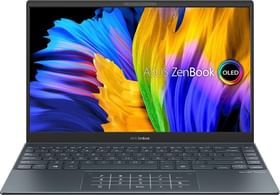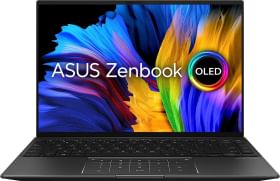Asus ZenBook 13 OLED Review Summary:
Expert Rating: 3.5/5
Design
Audiovisual
Keyboard
Performance
Pros
- Compact and lightweight design
- OLED benefits
- Impressive battery life
- USB-C Charging
- Dependable AMD CPU
- Fairly loud speaker
- Decent typing experience
- Large touchpad
- IR Face Unlock
Cons
- Sharp edges
- Not for GPU-intensive tasks
- No 3.5mm headphone jack
- Black Crush in some content
It’s been only a few years since manufacturers began using OLED displays on laptops. And like any new technology, they are expensive to make and there have been very few options to purchase too. Still, they are gaining momentum, ’cause like OLED screens on your smartphones, they give infinite contrast ratio, perfect blacks, and rich color reproduction. Simply put, you could expect a better visual experience than LCD panels. But as already mentioned, your options are limited and generally pricey. The only exclusion to this comes from Asus named ZenBook 13 OLED. It has got a 13-inch 1080P OLED panel and comes with a ₹99,990 sticker on top.
Now, that price tag is surely a lot of money. But, for an OLED laptop, it is one of the relatively affordable options you could get. And besides that display, other highlights of this machine are its AMD Ryzen 5700U processor, a 67WHr battery, and a very compact design. Here’s a glance of the complete contents and components it brings in the box:
Asus ZenBook 13 OLED Unboxing
The Asus ZenBook 13 OLED comes shielded by styrofoam in a cardboard box. Unpack it and here’s everything you’ll find:
- The laptop
- Adapter and Cord
- Documentation Papers
Also Read:
- Asus ROG Flow X13 Review: Gaming on the go
- Asus VivoBook Ultra K15 Review (KM513UA): Basics Done Right
- HP Omen 15 review (ek0023TX)
Contents
Asus ZenBook 13 OLED (UM325UA) Specs and Price in India

Dimensions and Weight: 304 x 203 x 13.9 mm; ~1.11 kg
Display: 13.3-inch Full HD (1920 x 1080) 16:9 OLED (Samsung ATNA33XC11-0) panel, 2.9 mm slim-bezel NanoEdge display, 100% DCI-P3 color gamut, TÜV Rheinland Eye Care certification, PANTONE Validated, 400 nits max brightness, VESA DisplayHDR 500 True Black, 2.2 Gamma Level
Processor: AMD Ryzen 7 5700U 1.8 GHz (8MB Cache, up to 4.3 GHz, 8 Cores, 16 Threads), 15W TDP
Graphics: iGPU: 512MB AMD Radeon RX Vega 8 Graphics
RAM: Up to 16 GB 3733 MHz LPDDR4x Dual Channel
Storage: Up to 1 TB M.2 NVMe PCIe 3.0 SSD
Keyboard and Touchpad: Edge-to-edge design, full-size backlit, with 1.4mm key travel; Wide Touchpad with NumberPad 2.0
Webcam: HD 720P (30FPS) IR camera
Audio: Built-in Analog microphone with Cortana voice recognition, Certified by Harman Kardon, dual-channel smart amplifier
Ports: 2 x USB 3.2 Gen 2 Type -C, 1 x USB 3.2 Gen 1 Type-A, 1 x HDMI 2.1, 1 x microSD card reader
Wireless connectivity: Dual-band WiFi 6 (802.11ax) + Bluetooth 5.0
Operating system: Windows 10 Home
Battery: 67 WHr 4-cell lithium-polymer with up to 16 hours run time; TYPE-C, 65W AC Adapter
Security: TPM 2.0
Price in India: ₹99,990
Now that you have a fair idea about what you get with the laptop, let’s get into its examination. This is the Smartprix review of the Zenbook OLED 13 (UM325UA) —

Asus ZenBook 13 OLED Design
If you have seen a ZenBook before, this would feel familiar. It has got a concentric circle design and a shiny Asus logo on the lid. Depending on the angle from where you look at it, you’ll see a moving hourglass-shaped sheen. It gets dulled by dust and dirt. But, you can easily wipe it clean.
Asus isn’t clearly trying to turn your heads with this hackneyed appearance. So, if not looks, what would definitely attract you is its portability. ZenBook 13 OLED weighs merely 1.11 kg and stretches just 13.9 mm diagonally. This means you could comfortably carry it around in hand or over your shoulders. Even it’s a cozily lapable lappy. But, it is when you do so, you’d notice some of its quirks.
One, the screen real estate is small, but you know that getting into this. Two, the angular edges although look sick, are too sharp. While typing or using the touchpad, my palms were hurting. And third, there was an audible teetering which could be a defect with just my unit. After all, it boasts US MIL-STD 810G military-grade standard for build endurance.

Anyways, lifting the lid makes us aware of its hinge strength. It goes back up to about 130-degrees. And while it does so, the base lifts a bit. Asus calls it ErgoLift which creates a breathing space beneath the board. Underneath is where you’d find the air vents and audio grille.


On the left side, you get an HDMI 2.0b port, two USB 3.2 Gen 2 Type C ports (charging supported), and by the right side, a USB 3.2 Gen 1 Type-A socket and one microSD card reader. There is no 3.5mm jack or ethernet port here. The product page says adapters for both these are bundled with the box. However, I didn’t get ’em. Even if you don’t mind the absence of the RJ45 port, the lack of jack would be sorely missed. So, you are left with the choice of using a connector for both these things. Or, in the case of audio, rely on Bluetooth 5.0 based TWS earphones. We will read how that works in the next section. But, before that know that for wireless connectivity, you are getting dual-band Intel WiFi 6 as well.
Moving on…

Asus ZenBook 13 OLED Audiovisual
The most distinguishing feature of this laptop is its 13-inch OLED display. Well, it’s right there in its name. And for good reason as visuals on this screen is great. It’s a PANTONE color-certified screen with 1080P resolution, 10-bit color depth, 100% DCI-P3 and sRGB color coverage, 1000000:1 contrast ratio, and about 400 nits of peak luminance. Everything looks sharp and well-defined with popping colors. This should be a good panel for color-sensitive works.
There is HDR support too along with VESA DisplayHDR 500 True Black. Toggle Use HDR within Display Settings in Windows 10. This although enhances supported content, makes SDR visuals look all washed out.
But, all’s not sunshine and rainbow on this screen. While watching Constantine (2005), I noticed a glaring issue. In dark scenes, which the movie had many, the dark areas were pixelated. I saw this in Saving Private Ryan (1998) and Loki (2021) too. I did an inspection on this Black Crush occurrence and here’s what I found — At 40%, 50%, 60%, 90% and 100% the black portions of the screen get all choppy and blocky. In other brightness levels, things are detailed and appear as they should. So, it is pertinent to some content only. This probably has something to do with the inconsistent per-pixel gamma levels. If you are able to calibrate the screen or use it within certain brightness levels, you should be able to work your way around it.
As far as the risk of OLED burn-in is concerned, the Asus Product team is confident that the panel should endure for more than 4 to 5 years with regular use. They also emphasized the use of techniques like OLED Care including a custom Screen Saver and Pixel Shift measure to allay any chance of a burn-in.
Other panel parameters you may care about are 60Hz refresh rate, a not-so-modern 16:9 aspect ratio, TÜV Rheinland rating for eye care (within MyASUS app), and 2.9 mm NanoEdge bezels on the sides. Being a glossy display, you might also see your reflection in pitch black imagery.
Coming to sound, the Harmon Kardon certified speakers with some tweaking in the DTS app produces a loud sound. The audio set up also includes a built-in analog microphone with Cortana voice recognition. You can also enable AI Noise-canceling for both mic and speaker which does benefit in the video calls. Speaking of which, the 720P Webcam outputs soft and peachy pictures. There is IR-based Windows Hello for the face which unlocks quickly provided you are within a range looking at the cam.
Else you can always enter a PIN or password using the keys below —

Asus ZenBook 13 OLED Keyboard
ZenBook 13 OLED has an edge-to-edge keyboard with a 1.4mm key travel and white backlight. You can switch between three brightness levels or turn it off. The keys offered good feedback, although the small handrest space on either end of the touchpad means my palms were chafing against the sharp edges of the board. And it was painful.
But the smaller handrest space is due to a wide touchpad. The touchpad works fine with precise tactility and false touch resistance.
Since there are no hardware number keys on the board, but you can always enable the Numberpad 2.0 which is a digital alternative. You can activate this by force touching the top right-cornered icon. I didn’t find it useful but you might.

Asus ZenBook 13 OLED Performance
The system boots on 64-bit Windows 10 Home with pre-installed apps like McAfee and MyASUS. The first thing I do is to uninstall the former. The latter I don’t mind as MyASUS is a hub of utilities like:
- Battery Health Care to set max charging limit (100%, 80%, or up to 60%)
- Fan Profile between Performance, Standard and Whisper mode
- AI Noise Canceling for Microphones and Speakers
- ASUS OLED Care (a custom screen saver, Pixel Shift measure against Burn-in)
- Various Picture Modes like Normal, Vivid, Manual and Eye care
- Internet priority setting for various use cases
- WiFi SmartConnect
- Function Key Lock
- Link to MyASUS with options like Shared Cam (repurposing phone’s camera for webcam), share files, URL links, screen sharing, etc.
- System info and diagnosis
ZenBook 13 OLED support Windows 11 as you can see below:

Now, hardware-wise, it ships with an octa-core AMD Ryzen 7 5700U chipset based on 7nm Zen 2 architecture clocked at 1.8 GHz with boost speeds up to 4.3GHz. There is hyperthreading with 16 threads and an 8MB L3 cache. The memory configuration is 16gigs (2x8GB) of LPDDR4x RAM and 1TB of PCIe SSD. The system didn’t sweat in my daily workload which includes around 30 odd Edge tabs, Spotify playing in the background, some YouTube videos, basic photo editing, etc. It’s just some sporadic occasions, the Windows Explorer would freeze and I will kill it in the Task Manager. Rest, I didn’t face any trouble while using it for a few weeks.
Even the synthetic exams were as expected out of this setup:
| Asus ZenBook 13 OLED Benchmark (Plugged-in) | Scores |
| 3DMark Sky Diver | Night Raid | 11492 | 12817 |
| Cinebench R20 | 2768 |
| CrystalDiskMark Seq Read | Write Speed | 3598.66 | 3154.08 MB/s |
| CrystalDiskMark Random Read | Write Speed | 813.78 | 434.44 MB/s |
| Geekbench 5 Single-Core | Multi-core (CPU) | 1174 | 6027 |
| PCMark 10 (Modern Office) | 5234 |
| Handbrake test (1GB WebM file to H.265 MKV 1080p30 conversion) | 37 min |
| Blender bmw27 | classroom | 5m32s | 15m18s |
As for graphics, there is an integrated Radeon RX Vega 8 GPU. This is not a machine meant for gaming, but I did run few games just for the heck of it:
- Rocket League: 36 FPS
- Valorant: 62 FPS
- GTA V: 16 FPS
With everything you run on it, the 67WHr battery empties in around 10Hr in the PCMark 10 test. In actual use too, it could easily cover a day’s power requirements (more than 14 hours). And I’m very pleased with the battery backup on ZenBook 13 OLED. At this point, the USB-C 65W charger is the icing on the cake. It charges in about 2 hours.
And finally, it’s time for the conclusion:

Review Verdict: Should You Buy Asus ZenBook 13 OLED?
Editor’s rating
So as already mentioned at the beginning of this review, if you are in the market for an OLED laptop, this is where you ought to start. With some calibration, this 13-inch panel becomes a feast for the eyes. If you belong to a microcosm of creators with color precisive work, then also you could consider this. The AMD CPU-GPU combo, up to 16GB RAM, 1TB SSD, and the 67WHr battery carries enough power for a thin and light chassis like this which should be able to drive most pro tasks and tools for an extended course. All that and the compact form factor allows for excellent portability too.
It’s just that while carrying it around, you’ll have to take along the 3.5mm jack connector or the ethernet one (if you need them), and while typing on it, put up with the sharp edges.
But that should be a small cost to pay for an otherwise bang for buck product. Compared to its OLED counterparts, the ZenBook 13 OLED is way less expensive. And with it, Asus has paved the way for more affordable OLED notebooks to come.
Reasons to buy
- Compact and lightweight design
- OLED benefits
- Impressive battery life
- USB-C Charging
- Dependable AMD CPU
- Fairly loud speaker
- Decent typing experience
- Large touchpad
- IR Face Unlock
Reasons to not buy
- Sharp edges
- Not for GPU-intensive tasks
- No 3.5mm headphone jack and Ethernet port
- Black Crush in some content











































